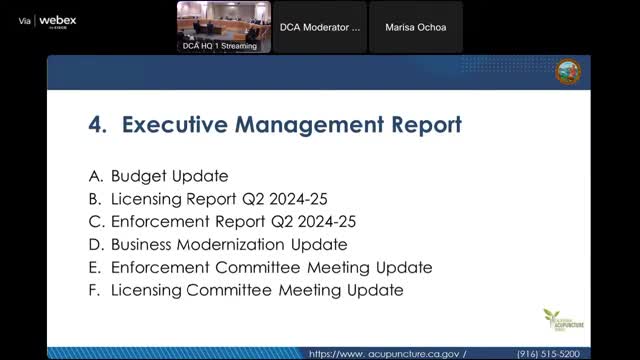California Acupuncture Board projects healthy reserves but flags potential future cost pressures
March 08, 2025 | Respiratory Care Board of California, Boards and Commissions, Executive, California
This article was created by AI summarizing key points discussed. AI makes mistakes, so for full details and context, please refer to the video of the full meeting. Please report any errors so we can fix them. Report an error »

The California Acupuncture Board will finish the 2024–25 fiscal year with a projected fund balance of about $5.7 million, or roughly 16.2 months in reserve, the Department of Consumer Affairs budget office told the board at its March 7 meeting.
Rachel Lanzoni, a DCA budget analyst, presented the board’s fund condition statement, saying the board began the prior year with roughly $4.4 million, collected about $4.1 million in revenues and expended roughly $3.7 million. For 2024–25 the board projects receipts around $4.4 million and expenditures near $3.3 million. "The board had a beginning base budget of approximately 3,800,000 and is projected to spend approximately 3,200,000, creating a reversion to the board's fund of approximately $660,000," Lanzoni said.
The numbers include license-renewal receipts, delinquent-fee collections and modest investment income. Lanzoni noted the agency uses conservative ongoing increases (about 3%) to model rising personnel and retirement costs in later years.
Why it matters: The board’s reserve level is comfortably under the 24-month ceiling set out in Business and Professions Code 128.5 but above commonly advised levels. Board members asked about the recommended months in reserve; Lanzoni said a healthy months-in-reserve range is commonly 6–9 months and that the Department of Finance guidance caps reserves below 24 months.
Future risks flagged: Lanzoni told the board that personnel cost growth (salary increases, retirement rate adjustments) is the single largest driver of potential future spending increases. She also cited two Department of Finance budget letters — BL 2420 (vacancy savings and position elimination) and BL 2424 (government efficiencies reductions) — that direct statewide reductions and could be reflected in the May Revision. "Any future legislation or unanticipated events may result in the board's need for additional resources, which would create cost pressure on the fund," Lanzoni said.
Board reaction and follow-up: Board members pressed staff on reserve benchmarks and the potential impact of statewide workforce reductions. Lanzoni repeated that the board’s current reserve is healthy but that the budget office will continue monthly monitoring and will report back as fiscal months close.
Ending: The budget office will continue to track revenue and expenditure trends and update the board; staff emphasized the projection is a snapshot in time and that adjustments — notably salary and statewide control measures — could change the long-term outlook.
Rachel Lanzoni, a DCA budget analyst, presented the board’s fund condition statement, saying the board began the prior year with roughly $4.4 million, collected about $4.1 million in revenues and expended roughly $3.7 million. For 2024–25 the board projects receipts around $4.4 million and expenditures near $3.3 million. "The board had a beginning base budget of approximately 3,800,000 and is projected to spend approximately 3,200,000, creating a reversion to the board's fund of approximately $660,000," Lanzoni said.
The numbers include license-renewal receipts, delinquent-fee collections and modest investment income. Lanzoni noted the agency uses conservative ongoing increases (about 3%) to model rising personnel and retirement costs in later years.
Why it matters: The board’s reserve level is comfortably under the 24-month ceiling set out in Business and Professions Code 128.5 but above commonly advised levels. Board members asked about the recommended months in reserve; Lanzoni said a healthy months-in-reserve range is commonly 6–9 months and that the Department of Finance guidance caps reserves below 24 months.
Future risks flagged: Lanzoni told the board that personnel cost growth (salary increases, retirement rate adjustments) is the single largest driver of potential future spending increases. She also cited two Department of Finance budget letters — BL 2420 (vacancy savings and position elimination) and BL 2424 (government efficiencies reductions) — that direct statewide reductions and could be reflected in the May Revision. "Any future legislation or unanticipated events may result in the board's need for additional resources, which would create cost pressure on the fund," Lanzoni said.
Board reaction and follow-up: Board members pressed staff on reserve benchmarks and the potential impact of statewide workforce reductions. Lanzoni repeated that the board’s current reserve is healthy but that the budget office will continue monthly monitoring and will report back as fiscal months close.
Ending: The budget office will continue to track revenue and expenditure trends and update the board; staff emphasized the projection is a snapshot in time and that adjustments — notably salary and statewide control measures — could change the long-term outlook.
View full meeting
This article is based on a recent meeting—watch the full video and explore the complete transcript for deeper insights into the discussion.
View full meeting
